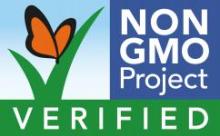
GMO foods and pesticides have a toxic relationship that’s playing out in your grocery store and probably your kitchen. Here’s why, and how, to steer clear of toxic pesticides and their GMO partners.
What are GMOs?
As defined by the Non-GMO Project, “a GMO, or genetically modified organism, is a plant, animal, microorganism or other organism whose genetic makeup has been modified in a laboratory using genetic engineering or transgenic technology. This creates combinations of plant, animal, bacterial and virus genes that do not occur in nature or through traditional crossbreeding methods.”
What foods are GMOs in?
Genetically engineered (GE) crops currently on the market are: corn, soy, alfalfa, canola, cotton, papaya, sugar beets, zucchini, yellow summer squash, potatoes, and apples.
In the US, GMOs are in as much as 80% of conventional processed food and more than 95% of animals used for meat and dairy eat GMO crops.
The following product ingredients are likely derived from GE crops: Amino Acids, Aspartame, Ascorbic Acid, Citric Acid, Dextrose, Flavorings (“natural” and “artificial”), High-Fructose Corn Syrup, Hydrolyzed Vegetable Protein, Lactic Acid, Maltodextrins, Molasses, Monosodium Glutamate, Sodium Ascorbate, Sodium Citrate, Sucrose, Textured Vegetable Protein (TVP), Xanthan Gum, Vitamin C, Vitamin E, Yeast Products, and many more.
GMOs can also be found in newer products like plant-based meat substitutes, such as the genetically modified yeast in the Impossible Burger.
Note that the USDA’s bioengineered (BE) label has a narrower definition of GMOs, meaning several food products are exempt from carrying the label or have a QR code label, putting the onus on consumers to get out their phones and do research themselves while in the store.
In addition, when modified seeds spread pollen, or seeds are spread from birds or fruit, GMO foods can contaminate non-GMO crops.
Globally, GMOs are treated as more of a concern than they are in North America, with several countries banning their cultivation.
Should I avoid GMO foods?
GMO foods are modified and grown to be resistant to synthetic pesticides and herbicides, which can easily lead to overuse of these chemicals linked to serious health problems.
Pesticides are substances meant to protect crops from various pests. In industrial agriculture, synthetic chemical pesticides are commonly used to protect plants from insects, weeds, and fungi. GMO foods are modified and grown to be resistant to synthetic pesticides, which can easily lead to overuse.
The herbicide RoundUp’s usage rose 1500% between 1995 and 2015—because GMO crops had been grown to be resistant to it. In 2015, the World Health Organization classified glyphosate, the main chemical in RoundUp, as a possible carcinogen. Since then, there have been several successful lawsuits against RoundUp producer Monsanto/Bayer for people who developed cancer after exposure to RoundUp. Monsanto/Bayer is also one of companies that manufactures GMO seeds.
The toxicity of pesticides most directly affects farmworkers but can also have negative impacts on consumers over time. Research on the effects of glyphosate residues on the foods we eat are in the early stages but scientists in the Environmental Working Group warn that the chemical is biologically persistent and chronic, and that food companies should be driving the reduction of glyphosate use by their supply chains.
As weeds and other pests evolve to become resistant to glyphosate, the agricultural industry is turning to even more toxic pesticides.
A 2022 report from George Washington University revealed that one in three Americans have detectable levels of the herbicide 2,4-D—a 23% rise since 2001. This chemical is one of the main ingredients in the bioweapon Agent Orange.
How do GMO crops affect the environment?
Another big question surrounding GMOs is how they interact with the world around them. The production of GMO foods requires mono-cropping—growing the same variety of crop in the same area year after year. This depletes nutrients and fertility in the soil, thereby forcing farmers to turn to damaging products like nitrogen fertilizers made from fossil fuels.
In addition, overuse of pesticides doesn’t just pose a risk to health. Increasing their use has also led to pollinator decline, creation of chemical-resistant superweeds and pests, and disruption of local ecosystems.
How can I avoid GMOs and pesticides?
Avoid GMOs by looking for products that carry the Non-GMO Project Verified label. To avoid pesticides, look for the USDA Organic label. The best option, when available, are products with both labels.









